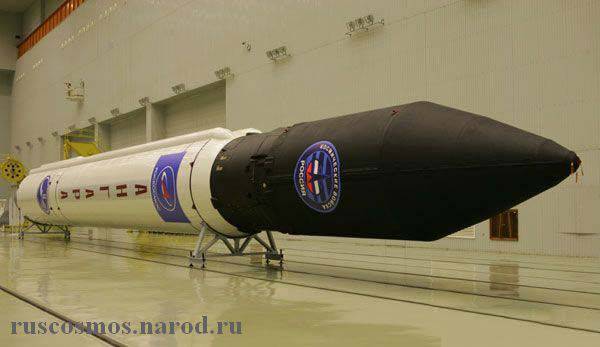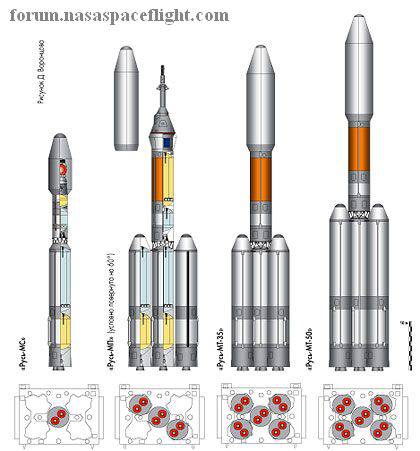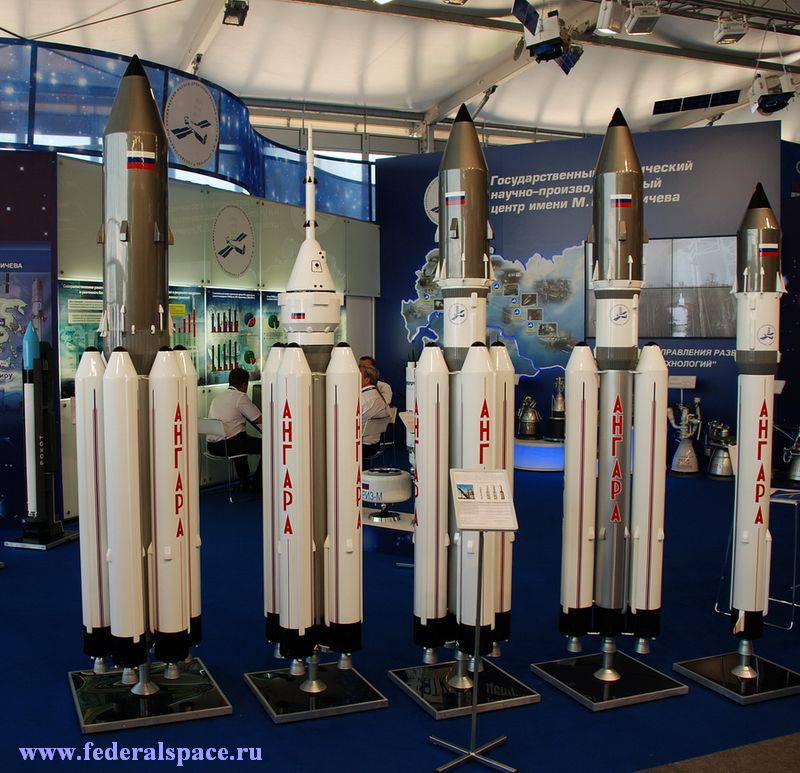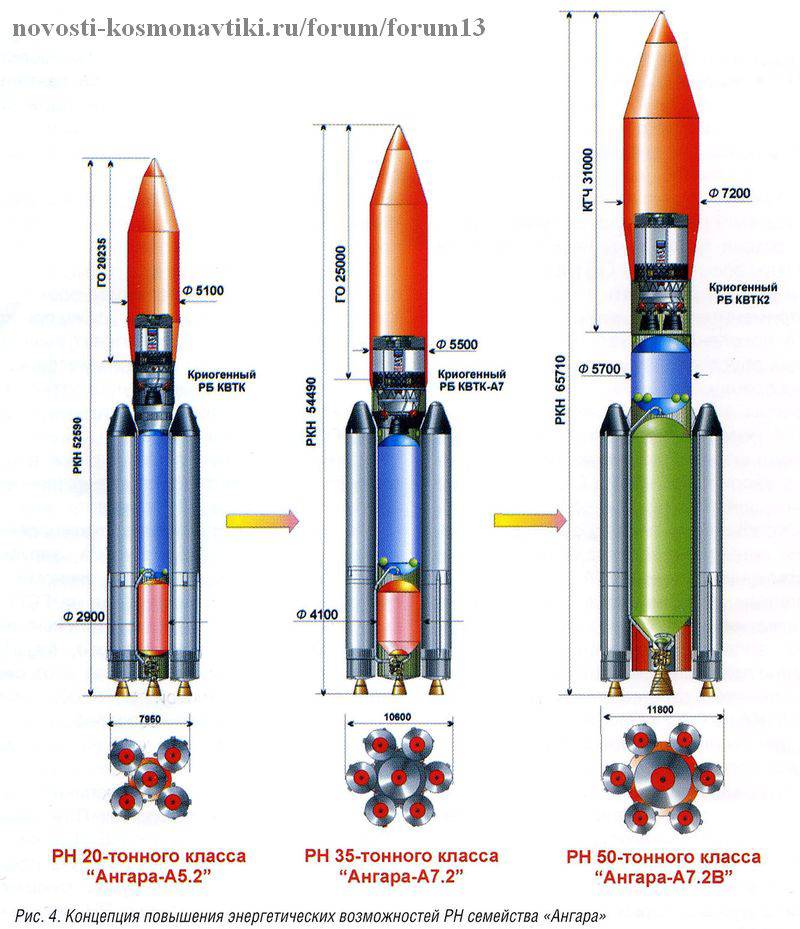Not such times are now to close the "Angara"

Our main, most advanced project in the field of space carriers - Angara - turns out to be a failure ?! In vain, wrong to be closed?
So you could think, after reading an article that appeared in 19 December in Izvestia with the title “Oleg Ostapenko considers the main space project of Russia of the last decades to be a dead-end solution”. Note, even without a question mark - definitely.
That's funny…
Oleg Ostapenko is the current head of Roskosmos, so it’s not a mess. And if you look at what the cursor gives when you hover over the address of the page (I do not remember how correctly it is called - what is written on the header of the browser tab). So, it says there “The Head of Roskosmos is ready to abandon the“ Angara ”- that is, well, not at all.
Here is what he said (I quote from Izvestia):
“I have been engaged in Angaroy for a long time, since the beginning of my activity as the head of the cosmodrome, then commander,” said Ostapenko at the meeting. - Personally, my belief that this rocket for the East is a dead-end rocket, it will not give us the opportunity to develop. We will then have to invest a lot of money again and build something else next ... I think that Angara is a dead-end solution for the subsequent development of our country in this area. ”
Let's see why it so suddenly turned out. What are these flaws found Ostapenko in the "Angara", which at once made it a dead end?
I have no other information about this, except for the article in Izvestia; here it and we study.
I read two claims in the article.
Too long
The first is the development time. From “Izvestia”:
“The first launch of the“ Hangars ”of the light class was planned for 2007 year, was postponed several times and now stands in the plans for the middle of 2014 of the year”.
20 yo ... sounds awful.
But the reason is clear! I already wrote about this in the old blog (http://bwana.ru/?p=494):
“... one of the contestants, the Angara Khrunichev rocket, has been developed since the middle of the 1990s. I confirm that he himself participated a little. Nobody wants to ask: why wasn't it developed? This is my first question, and in general terms I imagine the answer - as you understand, because I participated. The work went in fragments: the general contractor charges us money, and the “aggravation” comes, it does not charge, and then the chief designer rolls up the work, puts people on other tasks — a perpetual shortage of people, when such “impulse” financing. Since the end of 1990, I, as I recall, have experienced three such cycles. And, notice, each time most of the people at the next exacerbation turn out to be new, because the old ones have already been drawn into the other, and they put those who, in principle, by qualification, can still be busy no higher than the roof. ”
From the very beginning, “Angara” had a strong, violent opposition, and this affected the financing: it stopped and then resumed. It is also appropriate to recall both the paucity of the state budget and the organizational confusion of those years. Recall that if huge firms, general contractors, suffered from a shortage of funds, then the downstream cooperation enterprises, smaller, generally simply writhed, and others were fatal ...
But, in general, the timing is not really nagged. Probably also understand. The main complaint is cost indicators. From “Izvestia”:
“More than 1994 billion rubles have already been spent on its (Angara project) implementation since 100.”
First, the figure itself does not say anything definite. 100 billion rubles, or less 3 billion dollars - for space programs this can be a lot, and not much - depending on what has been done for this money. When amersky specialists decided that the implementation of the lunar program "Constellation" (launch vehicles "Ares-1" and "Ares-5", the manned ship "Orion", the landing lunar module "Altair") needed more than $ 100 billion This is 10 years ago, when the dollar was "heavier" today.
So the amount is less than $ 3 billion - maybe not so disastrous.
Secondly, I have already said: if it were not for the delays, the devastation in the industry and all that, then the costs would be less. In addition, I pay attention: what others have done during this time?
Where are they, all these Omegas, Yamals, Unions-2 and -3? I mean not the “Soyuz-2”, the former “Rus”, which is now putting 7-8 tons into near-earth orbits, but those “deep upgrades” that were supposed to output the 14-ton “Clipper”? Where are they? Where is the clipper itself? How much money is spent on these undertakings without endings?
Where, by the way, is another “Rus”, a new one, called “Rus-M”, which won the competition, announced in 2009, to create a rocket for the domestic lunar program?
Here it is, look:
 Handsomely? The largest option is 50 tons of payload. This project was closed by Popovkin in 2011 ...
Handsomely? The largest option is 50 tons of payload. This project was closed by Popovkin in 2011 ... And on the "Angara" - in November at the start took out a full-featured mock-up of the light version of the rocket, and the bench fire tests have been carried out for quite some time. And the Korean KSLV-1 RN has already flown three times into space, repeating the hangars on the 80% ...
So the first "Angara", you see, really take off next year - which, by the way, is about to come.
Probably spent over almost 20 years, can be left alone. In addition, they do not constitute the only, in fact, detailed reason for the “resignation” of the “Angara”. And it is the cost of the rocket itself.
Too expensive
I will not literally quote a certain high-ranking conference participant at the head of Roskosmos. He says that only one set of engines for the 1-stage heavy "Angara" is the same as the "Protons" flying this year - 1,25 billion rubles; however, there is a note right there that next year “Protons” are already being purchased for 1,5 billion.
That is, he says, the cost of the whole rocket will exceed 2,5 billion, plus at least 1 billion for the booster, fairing and launch services. And it turns out that in today's prices, the cost of launching a heavy "Angara" probably goes beyond $ 100 million.
Well, yes, more expensive "Proton". But do they want to replace him for nothing? Something in it does not suit, something "Angara" will be better? And for the "better" - is it not necessary to pay?
And then, what are we talking about? About how much you have to pay for the "Angar" now and in the near years? But now there is only a pilot production, the series is usually much cheaper. Some, again, a high-ranking representative, but already GKNPTs them. Khrunichev says the same in Izvestia: yes, today the Angara is almost twice as large as the Proton. But we plan to reduce the cost of the rocket by 2020 by 1,8 year. And in the series - so generally 2,5 times.
And he also recalls that the first "Protons" were three times more expensive than the serial ones, and the first "Unions" - three and a half ...
True, those $ 100 million for the launch, which are listed above, are estimates of third parties, and not the manufacturer's data; "Khrunichev" avoids the statements on the part of the cost. $ 100 million should be understood as the lower limit and therefore in no way hope that the cost of starting a serial “Hangars” will be 100 / 2,5 = $ 40 million.
Yes, damn it, and it's not so scary! Vaughn, the cost of launching a relatively new American Delta IV Heavy has been estimated at $ 254 million - in prices, note 2004 of the year. So, if the Angara, which has fallen in price in the series, will give not 40, but the same 100 million, then everything will be abgemaht.
There is in the article "Izvestia" another topic in terms of cost. I will highlight it in a separate chapter.
And generally it should not
They recall Elon Musk, the billionaire enthusiast who founded SpaceX, which, as far as I can tell, is now leading among the “privateers” working in the field of building space technology. They made the spacecraft “Dragon”, a light class FOLKEN-1 PH, and now the carrier of a heavy class (about 20 tons into a geo-transfer orbit) “FOLKEN-9” is being brought to mind.
They write that this very “Falken-9” launch will cost $ 78 million. Very much, they write, it will be a cheap rocket, cheaper than everyone. And this is explained, they say, by some special organization of production, which the monsters of the aerospace never had. Like, the monsters were focused on the narrow specialization of numerous participants in the cooperation; and Musk, they say, decided to do everything on his own.
I do not know how he does it. I was taught that specialized companies produce products cheaper than those who "do everything themselves." But Andrei Ionin says these words; and he is not only Ph.D. and corresponding member of the Russian Academy of Cosmonautics. Tsiolkovsky. He still has an MBA degree in Strategic Management. He probably knows better ...
Although I would suggest that Mask’s products are cheaper because they rely on the scientific and technical achievements of the very “monsters” that he is going to make in the market for commercial launches. Maybe that’s why he does everything himself, that he doesn’t have to invent technologies, and materials and units can be bought from the same “monsters” ...
And generally, let's see how much Falken-9 will cost when real commercial launches begin.
In general, I am for the "Angara". Although she, of course, has innate flaws.

From right to left - from light to heavy. With a spire emergency rescue system - manned. No heavyweight
At a meeting in Roscosmos, his head unexpectedly stated that the Angara launch vehicle project, nearing a great milestone - the first flight tests of the first model of a family of launch vehicles - that this project leads the Russian space program to an impasse. In the first part, I reviewed the claims to the project - of course, only those that are listed in the Izvestia newspaper, which published information about this meeting. And he came to the conclusion that they are insufficient for such harsh statements.
In this part, I will fantasize about the reasons for such a revision of the assessment - from the main perspective of the space industry to its impasse. But first, a few words about the real shortcomings of the Angara launch vehicle line-up concept.
Universal - good or bad?
The main one is the same universalism. Not even universalism itself, by which I mean building a line of rockets from light to super-heavy on the basis of unified rocket modules - on Khrunichev they are called - URM-1 and URM-2.
In the first 1995 studies of the year, the Angara looked quite differently from now. It was a two-stage rocket with a tandem arrangement of steps. The steps were tricky: in the main case of the steps, with a diameter of Zenit, there was an oxidizer tank and a propulsion system; and on it two fuel tanks of the same diameter were hung on the sides.
But in 1997, the concept began to be changed, and as a result, an assembly of two full-fledged missiles of two types, called URMs, appeared. Light, medium and heavy are collected from them - around 25 t of payload - and also super heavy - 35 and 50 t. There are no options for large loads that have official designations (at least, I don’t know), but there are conversations that you can actually bring it to 100 t.
So, in those years when the shape of a rocket assembled from URMs was being formed, the task of mass launching of relatively light spacecraft seemed particularly relevant, and URMs were focused on this type of load - 2 T to a low orbit.
This is what experts consider the main and, unfortunately, the fatal disadvantage of the Angara project.
And the fact that the assembly of different missiles from unified modules gives the worst results in weight efficiency than the individual development of each stage for each rocket, this, of course, is known. But here the mass factor should already work. With a sufficiently large series (to know what ...) the "universalistic" approach should save on the full aggregate of the costs of removing a kilogram of load.
Stumbling Block - Rocket for the Moon
Then, when Ostapenko commented on this meeting to the Izvestia journalists, he was not so categorical. He said that the program "Angara" will continue, that the start on the East will be built. But, they say, we need a rocket on 70 – 75 for the Moon, and there, you see, even more. And is it necessary to do this in the framework of the "Angara", this is a question. Now, they say, proposals for such a super-heavy rocket are being prepared by both RSC Energia and the Samara TsSKB Progress (let's add: and even Miass SRC im. Makeyev and someone else).
Great, all that great. But a little strange.
That's what's strange to me.
A few years ago, for the Moon, a rocket was considered necessary on 40 – 50 T. Vaughn, look again at the picture with “Rus-M” in the first part, there is the largest configuration - on 50 t. By the way, note, the previous one - on 35 T; exactly like Angara A7.2B and A7.2, respectively.

Now it turned out that what was needed was not 50, but 70 – 75 t. Good; But why in this reasoning, say, Rus-M is better than Angara? Nothing; and even worse, because the project "Angara", one way or another, will soon begin to fly. On the technical side, I once tried to compare Rus-M and Angara - of course, in an old blog. I got that Angara is better.
By the way, in the old blog I have written several articles in this vein for various informational reasons - about various projects and competitions announced over the last ten years. How can I put a lot of links to a third-party resource, maybe it's better for me, without too much delay, to transfer these articles here? The next turn in the technical policy of the space department is a good reason to gather in one place a retrospective of such turns. What do you think?
Okay, let's say, among the “post-Soviet” launch vehicle projects, there is not one that would explicitly include the PH on the 75 and payload — in any case, among the projects that received widespread press. It is necessary, like, to start from scratch.
But is this the reason for such categorical statements about the closure of the "Angara"? For the twentieth time I say: a project that has gone further than any other. A project that finally promises, in the real future, a heavy-duty new generation RF that Russia needs? "Proton" - this is the first generation! They will bury us!
No, not the reason. And all this talk about high prices, about non-optimality - all this is also a very weak argument. Where does the hope that competing organizations get cheaper and more optimal? Even if it happens on paper - who can vouch for what we come to at the end of the road? “Angara” can already somehow be calculated on the real material available.
But then why?
No one has yet canceled emotions ...
Somewhere in the early 1990-x in the GKNPTs them. Khrunicheva came to work a woman named Tatyana. Her last name was Dyachenko; if someone else does not understand, I will say straight - Yeltsin's daughter.
Under this case, Khrunichevsky General had a special relationship with the SAMM. Of course, I repeat the rumors, but what of this? We were told that for Tatiana they created a special unit that became involved in spacecraft. I don’t know how it is; but it seems to be true. According to my ideas, we (my design bureau) did their first satellite with them.
What is a special relationship, no need to explain; Yes, I do not know anything concrete. But it is clear that these are some preferences, some kind of support in controversial issues. Some, probably, opportunities to act through the head of the governing supervising state agency, whatever it was called (as if Rosaviakosmos were called then).
Well, the Khrunychev people made enemies for themselves - both among industry organizations and in these very state bodies. They say there was a banquet dedicated to some of the anniversary of one of the highest Khrunichevites. He was a friend of hiss almost from school, serving in the department. He talked for a long time about the merits of the hero of the day, about the importance and coolness of his work. And I finished the speech with the words: we will not miss your “Angar”.
They say there was a scandal. I asked the person who told me: was it such a joke that was awkward? No, he says, rather the puncture is not quite sober person ...
Interestingly, the next jubilee of that Khrunychivtsi, this irreconcilable friend, was already celebrating as a member of the GKNPT collective.
This is not a sentence
The previous head of Roscosmos, General Popovkin, was a clear supporter of the Angara. Regarding Ostapenko, there is no definite judgment on this issue. That is, there is no reason to state that he is an opponent. It is clear that competitors and simply disinterested enemies will try - and have already tried - to turn him against the "Angara". It's simple. And now it is especially simple with us, which is confirmed by the mess with contests and “epoch-making decisions”, which I recalled a little in the first part.
It may well be that General Ostapenko simply does not want to thoughtlessly pursue a line that they have not begun. It may well be that he has his own ideas about both the priorities of the space program and the proper organization of work on it. He could in the past short time, or even earlier, he is a lifetime in cosmic affairs; he could honestly come to the conclusion that if the task of settling the Moon before the Chinese was set, then a big rocket is needed - more than the largest of those that were presented before. In the end, because in those lines, there really wasn’t a 75 car or more tons. And why not hear about this Samara, which built the 120-ton "Energy"?
In general, it is early to order a dirge for the "Angara". So far, even the construction of the second start on the East has not been canceled; although the construction of the first has not yet begun ... Oh, our life is not easy, changeable ...
Information